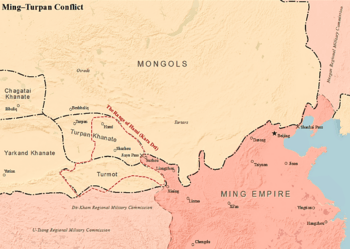Kara Del facts for kids
Quick facts for kids
Kara Del
哈密國
|
|||||||||||
|---|---|---|---|---|---|---|---|---|---|---|---|
| c. 1389–1513 | |||||||||||

Location of Kara Del
|
|||||||||||
| Capital | Hami | ||||||||||
| Common languages | Mongolian, Old Uyghur language | ||||||||||
| Government | Monarchy | ||||||||||
| Khan | |||||||||||
| Historical era | Post-classical | ||||||||||
|
• Gunashiri breaks away from Northern Yuan dynasty
|
c. 1389 | ||||||||||
|
• Kara Del accepts Ming supremacy
|
1404 | ||||||||||
|
• Conquered by Esen of the Northern Yuan dynasty based in Mongolia proper
|
1430s | ||||||||||
|
• Coup staged by pro-Mongol faction
|
1463 | ||||||||||
|
• Ming restores Gunashiri dynasty
|
1467 | ||||||||||
|
• Mansur Khan from the Chagatai Khanate overthrew the Gunashiri dynasty and the region's conversion to Islam
|
1513 | ||||||||||
|
|||||||||||
| Today part of | China | ||||||||||
Kara Del, also known as Qara Del, was a kingdom led by the Mongols. It was located in Hami, which is in modern-day Xinjiang, China. The kingdom was started around 1389 by a Mongol prince named Gunashiri. He was a descendant of Chagatai Khan, a son of Genghis Khan.
Kara Del was ruled by Gunashiri's family until 1463. It often paid tribute to the powerful Ming dynasty of China. From 1406, the Ming dynasty set up a special guard system in Kara Del. Even so, the kingdom was sometimes influenced by the Northern Yuan dynasty, another Mongol group. The ruler of Kara Del was called the "Obedient King" by the Ming. Kara Del ended in 1513 because of wars between the Ming and the Oirat Mongols. The name "Kara Del" means "Black chest" in the Mongolian language.
Contents
History of Kara Del
How Kara Del Started
In 1389, a Buddhist Mongol prince named Gunashiri decided to break away from the Northern Yuan dynasty. This dynasty was going through some changes at the time. Gunashiri settled in Hami by 1390. He ruled over the local Uyghur people. The very next year, the Ming dynasty took over his land. They made him agree to their rule, but he still got to control his territory.
Relations with the Ming Dynasty
In 1404, Engke Temiir became the new ruler after Gunashiri. He agreed to let the Ming dynasty set up a special guard system in Hami. However, the Ming did not directly rule Hami or collect taxes from its people. The Ming court gave Engke Temiir the title Zhongshunwang, which means "obedient prince."
Changes and Challenges
During the 1430s, Kara Del came under the control of the Oirats, another group of Mongols. The Uyghur people in Hami often met with Mongols from other regions. Some Uyghur leaders even became important figures among the western Mongols. This led to the spread of the name "Uyghurjin" as a clan name in the Ordos area.
In 1446, there were problems in Hami. Ming soldiers, led by Ren Li, took over the city. They moved about 1,230 people to an area east of Jiayuguan.
The End of the Kingdom
In 1463, the ruler of Kara Del was overthrown by a group that supported the Mongols. This caused a big problem over who would rule next. From 1467, the Ming emperors tried many times to put members of Gunashiri's family back in charge. But the situation in Hami never became stable.
Finally, in 1513, Mansur Khan, the ruler of Moghulistan, conquered Hami. Kara Del officially became an Islamic region in 1513. After this, the term Uyghur was not used much until the 20th century. It was only a local name for Muslim Turks in Hami and Turpan. In 1923, Uyghur was used again to describe the people living in the oasis towns of Xinjiang's Tarim Basin.
Culture and Beliefs
During the Ming dynasty, Buddhism continued to be practiced in areas like Turfan and Qocho, which were part of Uyghurstan.
Rulers of Kara Del
Here is a list of the rulers of Kara Del:
- Unaširi (1380–1393)
- Engke Temür (1393–1405) - He became a ruler under the Ming dynasty in 1404.
- Toqto (1405–1411) - Also a ruler under the Ming dynasty.
- Tör Temür (1411–1425) - Another ruler under the Ming dynasty.
- Budaširi (1425–1439) - He was first a ruler under the Ming, then under the Northern Yuan dynasty. He had rivals named Toγon Temür and Toqto Temür.
- Khalīl sulṭān (1439–1457) - He was first a ruler under the Northern Yuan, then under the Ming.
- Bürege (1457–1460)
- Nugandaširi (1460–1467), a queen.
- Qanšin (1472–1488)
- Engke Bolad (1488–1492) and (1493–1497)
- Šamba (1492–1493) and (1497–1505)
- Beyazıt (1505–1513)

